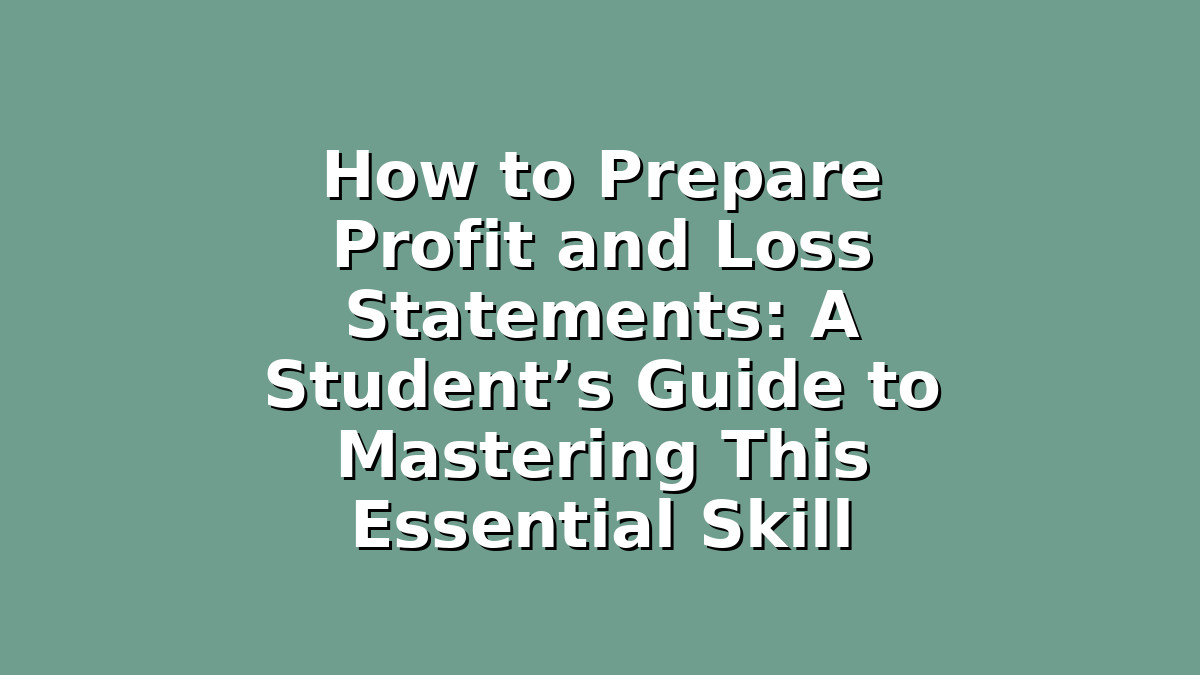Preparing Profit and Loss (P&L) statements is a fundamental skill for students studying accounting, finance, business, or related fields. Whether you’re preparing for exams, working on assignments, or aiming to build a strong foundation for your future career, understanding how to prepare accurate and clear P&L statements is crucial. This guide will walk you through the basic concepts and provide practical study tips to help you master the preparation of Profit and Loss statements effectively.
Introduction: Why Profit and Loss Statements Matter
A Profit and Loss statement, also known as an income statement, summarizes a company’s revenues, costs, and expenses over a period of time — usually a month, quarter, or year. It shows whether a business is making a profit or incurring a loss. For students, mastering this statement is not only important for exams but also helps you understand how businesses evaluate their financial health.
When preparing for your exams or coursework, you might feel overwhelmed by the details involved in creating these statements. However, with the right approach and study techniques, you can gain confidence and accuracy. This article breaks down the process into manageable steps and offers study strategies tailored to your needs as a student.
—
Section 1: Understand the Key Components of a Profit and Loss Statement
Before jumping into preparation, it’s essential to understand the main elements of a P&L statement. Familiarity with these components will make it easier to organize information and spot errors during your studies.
– Revenue (Sales): The total income earned from selling goods or services.
– Cost of Goods Sold (COGS): Direct costs tied to producing the goods or services sold, such as materials and labor.
– Gross Profit: Calculated as Revenue minus COGS. This shows how much money is left after covering production costs.
– Operating Expenses: Costs related to running the business, such as rent, utilities, salaries, marketing, and depreciation.
– Operating Profit: Gross profit minus operating expenses.
– Other Income and Expenses: Interest, taxes, or any other income/expense not directly related to operations.
– Net Profit (or Loss): The bottom line — the total profit or loss after all expenses are deducted.
Study tip: Use flashcards or a mind map to memorize these components. Create simple definitions or examples for each term to deepen your understanding. For instance, link “COGS” to a real-world example like the cost of ingredients in a bakery.
—
Section 2: Practice Organizing and Formatting the Statement
The next step to mastering P&L statements is practicing the proper layout and formatting. Clear organization is critical not only for your understanding but also for exam presentation.
1. Start with a Title — Include the business name, the title “Profit and Loss Statement,” and the reporting period.
2. List Revenues First — Always begin with total sales or revenue.
3. Deduct COGS — Subtract the cost of goods sold to find gross profit.
4. Add Operating Expenses — List each expense category (rent, salaries, utilities), then sum them up.
5. Calculate Operating Profit — Subtract operating expenses from gross profit.
6. Include Other Income or Expenses — Add or subtract any additional items.
7. Calculate Net Profit or Loss — This final figure shows the overall result.
Study tip: Use sample exercises or past exam papers to practice formatting. Try re-writing P&L statements by hand to reinforce your memory and help you become familiar with the flow. Creating your own templates can also boost your confidence when under time pressure.
—
Section 3: Develop Analytical and Problem-Solving Skills
Preparing a P&L statement isn’t just about plugging numbers into a template — it’s about understanding how those numbers interact and what they mean for a business. Developing your analytical skills will help you interpret results and apply your knowledge during exams.
– Check for Consistency: Verify that revenues, expenses, and calculated profits make sense logically. Unrealistic figures often indicate errors.
– Understand Relationships: For example, if operating expenses increase significantly without a corresponding rise in revenue, the net profit will decline.
– Solve Practice Problems: Work on exercises that provide raw financial data and require you to create a complete P&L statement.
– Ask “Why?”: Whenever you calculate a profit or loss, ask why that happened. Did costs rise? Was sales revenue lower than expected? This deepens your comprehension.
Study tip: Form study groups to discuss and solve P&L problems together. Explaining your reasoning to others reinforces your understanding. Also, seek feedback from teachers or tutors to identify areas for improvement.
—
Conclusion: Building Confidence Through Consistency and Understanding
Preparing Profit and Loss statements can seem challenging at first, but by breaking down the components, practicing formatting, and developing analytical skills, you’ll become more confident and prepared for exams. Remember, accuracy and clarity are key — so take your time to understand the numbers and their relationships.
As a student, your goal is not just to memorize formats but to truly grasp what a P&L statement tells you about a business’s financial health. Use a variety of study resources: textbooks, online tutorials, practice problems, and peer discussions. With consistent effort and the right techniques, you’ll master this essential accounting skill and be well-equipped for your exams and beyond.
Good luck, and keep practicing!
—

Responses